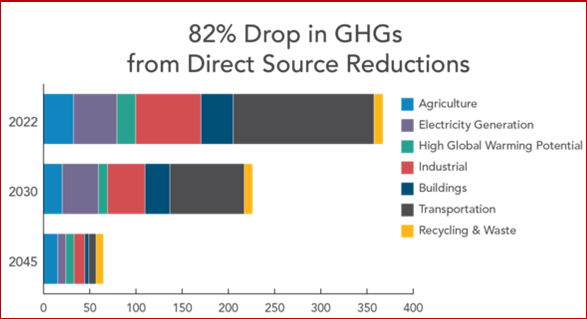The California Air Resources Board today proposed an aggressive climate action plan that drastically reduces fossil fuel dependence, slashes pollution, cuts greenhouse gas emissions by 85% It’s the latest blow to the well-funded lobbyists of Big Oil, climate-change deniers and other special interests. The plan will cut air pollution by 71%, reduce fossil fuel consumption by 86%, and reach carbon neutrality by 2045.
Since California is the fourth largest economy in the world*, it will have a tremendous impact on other US States and international economic blocks as the demand created for cleaner fuels and methods will be a so-called virtuous circle that encourages innovation and then adoption of what emerges for economies of scale.
“It’s the most ambitious set of climate goals of any jurisdiction in the world, and if adopted, it’ll spur an economic transformation akin to the industrial revolution. While big polluters focus on increasing their profits at our expense, California is protecting communities, creating jobs and accelerating our transition to clean energy,” said California Governor Gavin Newsom.
By 2045 under this strategy California would:
- Cut greenhouse gas emissions by 85% below 1990 levels
- 71% reduction in smog-forming air pollution
- Reduce fossil fuel consumption (liquid petroleum) to less than one-tenth of what California uses today – a 94% reduction in demand.
- Create 4 million new jobs.
- Save Californians $200 billion in health costs due to pollution in 2045
“This plan clearly and unequivocally presents challenging and ambitious goals, but we simply have no other choice but to meet them – and do it in less than a quarter century. We all have experienced firsthand the impacts of climate change, whether wildfires, drought, record-breaking heat waves and more. Failure is not an option. There is too much at stake and we need to move as fast and as far as we can to lessen the worst impacts of climate change and leave future generations a livable and healthy California,” said CARB Chair Liane Randolph.
The CARB Board will vote on the 2022 Update to the Scoping Plan at its December 15-16 meeting. The initial draft of the plan was considered by the Board at its June meeting and with the Environmental Justice Advisory Committee in September. The final proposed plan includes changes requested by the Board and the EJAC, as well as guidance from Governor Newsom. It also reflects direction from new state laws passed by the Legislature this year.
As a result, the final modeling for the Scoping Plan shows increased ambition, projecting a 48% reduction of greenhouse gases below 1990 levels in 2030, surpassing our statutory mandate to reduced emissions 40% below 1990 levels in 2030. The updated modeling also includes 3 million climate-friendly homes by 2030 (and 7 million by 2035), 6 million heat pumps deployed by 2030, no new fossil gas capacity in the electricity sector, and 20 gigawatts of offshore wind capacity by 2045.
Critically, the plan now provides a Climate Vulnerability Metric, a new tool to identify communities especially vulnerable to harm from a changing climate and worsening air quality, ensuring that those communities’ public health and environmental concerns are front-and-center as the state moves ahead.
*Implementation of the plan would keep California on track to continue growing the economy and jobs, including green jobs tied to industries such as electric vehicle and zero-emission truck manufacturing that position California as a major competitor in the global clean-energy marketplace. Economic modeling indicates that, under the plan, California’s economy will reach $5.1 trillion by 2045 (from $3.2 today), with a related increase in 2045 of at least 4 million new jobs. (AutoInformed: CARB to Launch Small Fleet ZEV Conversion Incentives )



The California Air Resources Board today (11/17/22)approved a far-reaching $2.6 billion investment plan that ensures all Californians benefit from our state’s transition to zero-emission transportation. Supported projects range from incentives for cleaner trucks and buses, and mobility options such as bike- and car-sharing, to consumer rebates for clean cars.
This year’s investment dollars focus largely on under-served communities, including low-income communities and those disproportionately burdened by environmental pollution, as well as small truck fleets. Marking the state’s largest investment in equity, it is estimated that more than 70% of the $2.6 billion Fiscal Year 2022-23 Funding Plan for Clean Transportation Incentives will benefit priority populations.